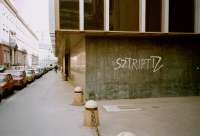Writing texts on the wall has a tremendous tradition in the folklore of big cities. It is one of the simplest ways to express freedom; the creators communicate with every citizen of the city in principle. They turn an intrinsically illegible town legible. Just think of the confessions, names preserved on the walls and other signs having lost their significance: The majority of them are occasional inscriptions defended by nothing, neither physically nor morally; to the contrary, people seek to remove them. One of the important aspects of the inscriptions is that they are born in spite of a serious prohibition, even the most ordinary graffiti is an illegal damage in principle; haste, shortness and incompleteness are consequences of this. Its physical frame is determined by the features of human body: every graffiti is also the movement-notation of its realization.
I would like to record one or more inscriptions of this kind, that is, to lengthen its natural lifetime by placing it into the medium of art. So I would like to preserve this inscription by casting it into aluminum or bronze; I would cast the original typography into bronze about 2 cms thick and place it onto the wall covering the original painted characters. I would hope to call attention to the graffiti by this particular art, by raising the monument in the memory of an old fleeting thought, of an unknown person who applied unconsciously the instrument of art in order to break out his/her restrictions. At the same time this procedure demonstrates the good-act character of art: it transfigures a deformed wall into a work of art.
(the submitted image is a photoshop rendering of a Budapest graffiti)
Writing texts on the wall has a tremendous tradition in the folklore of big cities. It is one of the simplest ways to express freedom; the creators communicate with every citizen of the city in principle. They turn an intrinsically illegible town legible. Just think of the confessions, names preserved on the walls and other signs having lost their significance: The majority of them are occasional inscriptions defended by nothing, neither physically nor morally; to the contrary, people seek to remove them. One of the important aspects of the inscriptions is that they are born in spite of a serious prohibition, even the most ordinary graffiti is an illegal damage in principle; haste, shortness and incompleteness are consequences of this. Its physical frame is determined by the features of human body: every graffiti is also the movement-notation of its realization.
I would like to record one or more inscriptions of this kind, that is, to lengthen its natural lifetime by placing it into the medium of art. So I would like to preserve this inscription by casting it into aluminum or bronze; I would cast the original typography into bronze about 2 cms thick and place it onto the wall covering the original painted characters. I would hope to call attention to the graffiti by this particular art, by raising the monument in the memory of an old fleeting thought, of an unknown person who applied unconsciously the instrument of art in order to break out his/her restrictions. At the same time this procedure demonstrates the good-act character of art: it transfigures a deformed wall into a work of art.
(the submitted image is a photoshop rendering of a Budapest graffiti)
